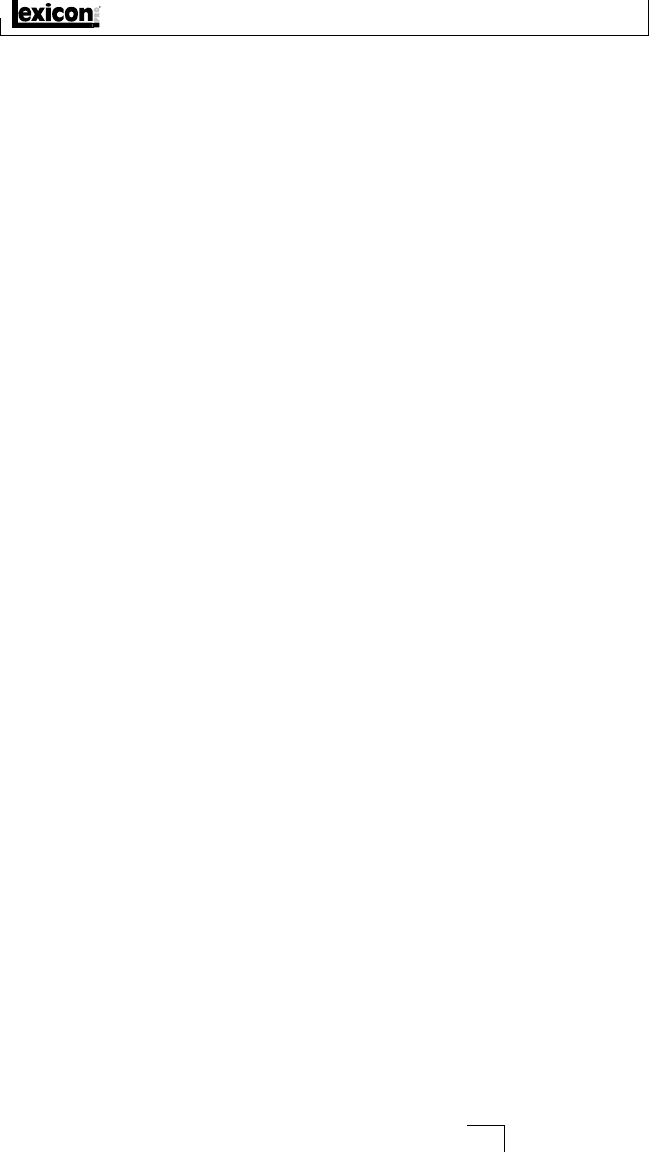
ECHO LEVEL LEFT/RIGHT
In many real spaces, distinct reflections and echoes are an important part of the sound.
Although many natural-sounding environments use little or no echo there are some
cases where they can be used to help define the size of the space or to give a slapback
or doubling of the diffused sound. The echo signals are fed from the diffusion section
to the left and right output with independent control of the left and right echo levels.
These levels, when used, should be set to lower than the original signal with values in
the range from -6 dB to -24 dB the most useful.
ECHO TIME LEFT/RIGHT
For natural echo sounds, the setting of the echo time is very dependent on the size of
the reverberating space. For slapback settings used to enhance the original sound, set
the echo time in the range of 60 to 85 milliseconds. The left and right echoes should
be set exactly the same or at least 10 milliseconds apart from each other to avoid any
comb filter coloration.
SPREAD
Spread works to control the profile of initial reverberant-energy growth. Spread
stretches or compresses the energy contour in time to make reflections closer together
or further apart. Spread will change the feel of the reverberant space and gives the
user some latitude to fit the reverb to the source material. It may be advisable to use a
moderately low value for spread to create a bit of space around the original signal. For
non-percussive, single instrument reverb settings higher values of Spread can add a
perceived widening and thickening to the material.
DIFFUSION
Diffusion models the effect of irregular wall surfaces in a room by changing echo
density. Very low values produce sharp, discrete, early reflections. Higher values
produce groups of reflections that are smoother but less articulated. This is an
important parameter to adjust to create a natural feel to the reverb. Higher Diffusion
settings are common for the most natural-sounding environments. Lower settings are
useful only on specialized reverbs where the source material is not percussive such as
vocals and horns.
BASS BOOST
Bass Boost controls the low frequency reverberation time relative to the RT60
parameter. If, for example, Bass Boost is set to 2.0X and RT60 is set to 1 second, the
effective low frequency is extended to 2 seconds. For natural- sounding results, use
settings of 1.5X or less. For longer RT60 settings and larger room sizes the maximum
effective value for the BassRT parameter is scaled back to avoid instability. BassRT
values less than 1.0X produce a low frequency RT that is shorter than RT60 which can
be used to create reverbs without low rumble. This can be desirable for fitting a
reverberated track such as vocals within a desired frequency range for the final mix.
BASS FREQ (FREQUENCY)
Bass Freq sets the frequency at which the transition between RT60 and Bass Boost takes
place. Values in the range of 200 Hz to 400 Hz works best for natural-sounding reverb.
Except for special effects, there is seldom a need for this parameter to exceed 500 Hz.
DESCRIPTION OF PARAMETERS
11


















